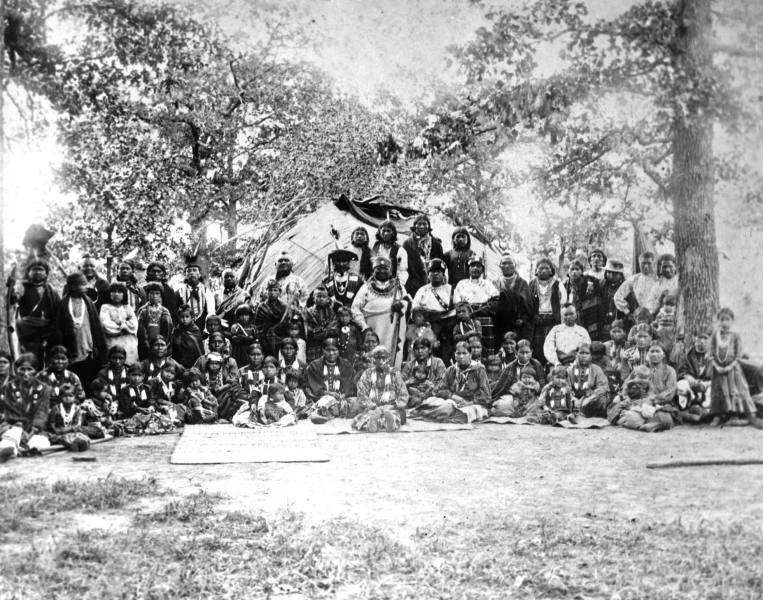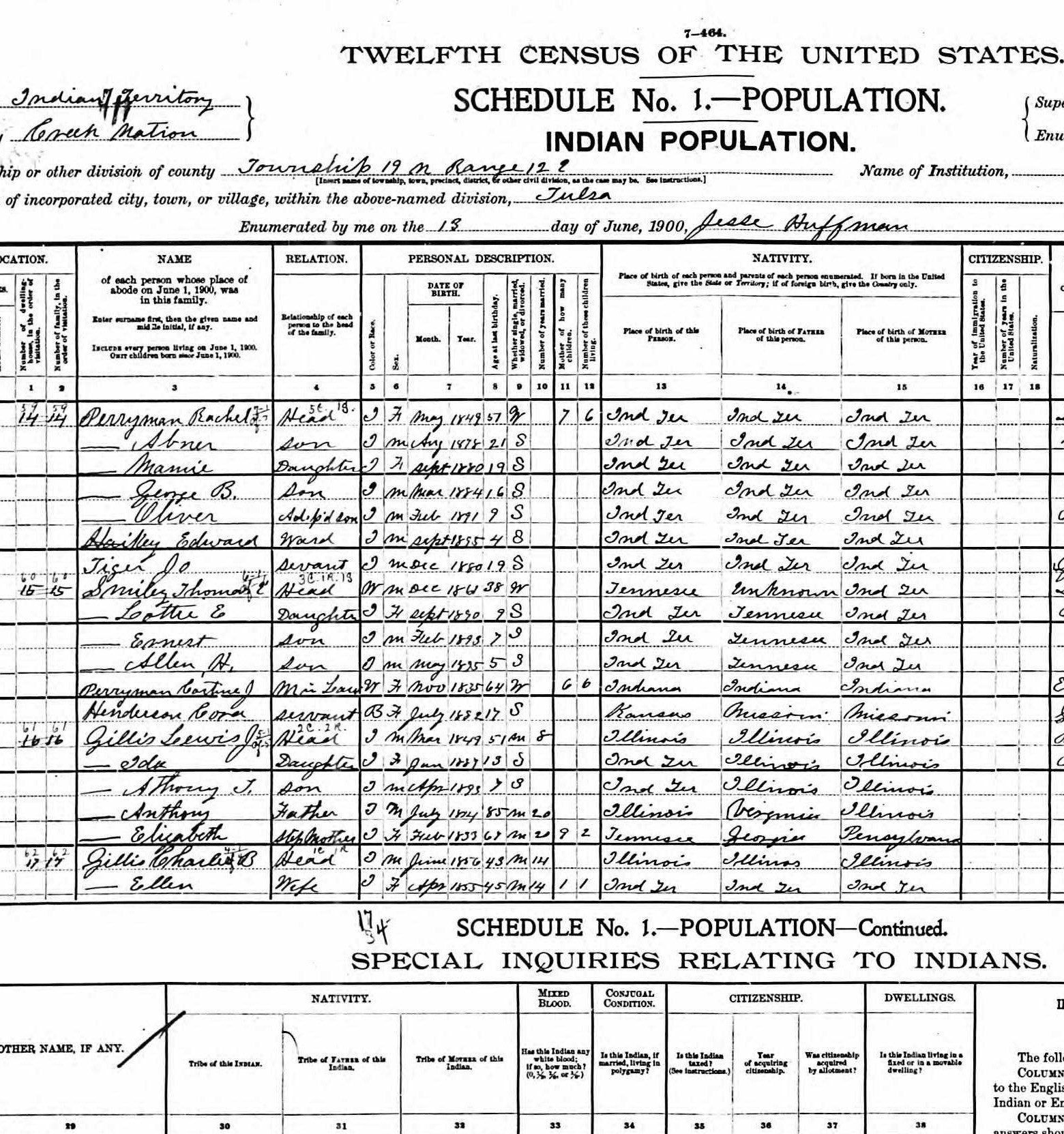American Indian Research
Documenting American Indian heritage requires thorough research of both individuals and families. Many families have oral traditions of family members who were members of the Five Tribes living in Oklahoma. These tribes developed a relationship with the United States government long before other tribes. Because of this long-standing relationship, tribal records exist for most of the 19th century. These records are available and can be used to discover and document American Indian heritage.
The Five Tribes
The Five Tribes consist of the Cherokee, Choctaw, Chickasaw, Muscogee (Creek) and Seminole tribes. These tribes were removed to Oklahoma in the late 1830s and early 1840s from their homelands in the southeastern United States. Each tribe was given land in what was then known as Indian Territory.
Rolls and censuses were taken from the time of arrival in Oklahoma, and some pre-removal rolls exist. These records vary by tribe and date, and the information varies depending on the reason the roll was taken. Some are only lists of names so other records will be needed to determine the identification of the individual.
Between 1898-1906, the "Final Rolls of the Five Civilized Tribes" or Dawes Rolls were taken to determine tribal affiliation and who qualified for land allotments prior to Oklahoma becoming a state. This roll is what is used today to determine tribal enrollment.
The Genealogy Center has records of the Five Tribes dating from the 1830s to around 1910s. Included are census records, rolls, applications, accounts of legislative sessions, court dockets, correspondence, election records, treasurer's records, materials relating to land allotment and leases, and school records.

1900 Federal Census
 The first step to determine whether your ancestor was enrolled on the Dawes Roll is to locate them in the 1900 federal census. Knowing the approximate age of the ancestor at that time and the names of any family members (parents, children, spouses) who may have been listed with them will be helpful in verifying the correct family on the rolls. If you are not sure of the age of your ancestor or other names of family members, you may need to acquire more information from other family members, or find a descendant on the 1930 or 1940 federal census and trace backwards to the 1900 from there.
The first step to determine whether your ancestor was enrolled on the Dawes Roll is to locate them in the 1900 federal census. Knowing the approximate age of the ancestor at that time and the names of any family members (parents, children, spouses) who may have been listed with them will be helpful in verifying the correct family on the rolls. If you are not sure of the age of your ancestor or other names of family members, you may need to acquire more information from other family members, or find a descendant on the 1930 or 1940 federal census and trace backwards to the 1900 from there.
Since the rolls were taken to determine who qualified for a land allotment, those enrolled had to meet certain requirements. These requirements included living in Indian Territory with the tribe and being listed on earlier tribal rolls taken before 1898. The Dawes Commissioned used the earlier rolls which were taken by the tribes to verify whether an individual was actually recognized by the tribe as a member and therefore eligible for an allotment. To meet these requirements, individuals would listed as living in Indian Territory in the 1900 federal census.
Other important information on the 1900 census will be whether or not the individual reported their race as American Indian. Many non-Natives lived in Indian Territory so it may be possible that an ancestor was in the right place, but not affiliated with a tribe. Not being a recognized tribal member means these families will not qualify for Dawes enrollment.
Final Dawes Roll Index
However, if you ancestor does meet the above qualifications and is living in Indian Territory in the 1900 census, you can search the Final Dawes Rolls Index to locate your ancestor's tribe, roll number and census card number, or CC#. Also included on the index will be a designation of amount of Indian blood. The "blood" section will be members with Indian blood. The "minor" and "newborn" sections are names of children who enrolled. The "by marriage" section will be the names of non-Natives who were married to tribal members and the "freedmen" will be the names of the formerly enslaved families who were adopted into the tribes. Be sure to check the age of the person listed in the results of your search to verify it is the correct person. You may also see what other family members were listed on the card with your ancestor.
Fold3 Database
Now you are ready to look up your ancestor's enrollment card and application packet (for all tribes except Muscogee (Creek)) in the Fold3 database, which is only available at the Genealogy Center. Under "Native American Archives" browse the Dawes Enrollment Cards or Dawes Packets (you will search both the same way). Select your ancestor's tribe, their group (noted under "Tribe & Enrollment" in the index), card number, and then name. The census cards were the enrollment cards that were filled out for each family member who enrolled. Besides names of other family members, census cards contain the name of the father and mother of each individual, the former slave owner's name of the freedmen families, the place of residence of the family and earlier rolls that the family was listed on. These census cards may also help connect to earlier rolls of the tribe.
The information on the census card was taken from the application made by each enrollee. Applications exist for both accepted and rejected applicants. These packets usually include a transcript of the interview with the enrollee, which can provide interesting and useful information about your ancestors.
Historical Timeline of the Five Tribes
A brief outline of the historical events which occurred in Indian Territory resulting in the Dawes enrollment of the Five Tribes.
Finding Your American Indian Ancestors Research Guide
This guide will explain the necessary research steps for locating your American Indian ancestor.
Federally Recognized Tribes in Oklahoma
A list of the federally recognized tribes in Oklahoma.
American Indian Holdings in the Genealogy Center
A list by tribe of the American Indian records located at the Genealogy Center.